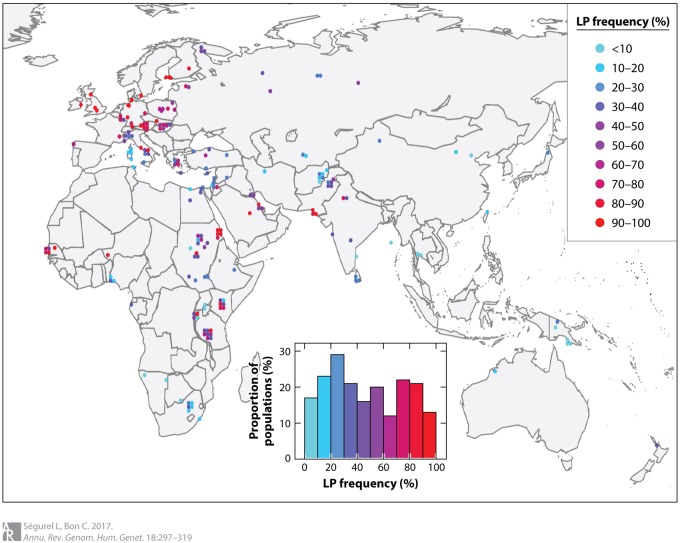LACTOSE INTOLERANCE
Lactose intolerance results from incomplete digestion of the milk sugar lactose. Primary lactose intolerance is characterized by gastrointestinal discomfort from osmotic diarrhoea and colonic bacterial fermentation of lactose. Lactose is found only in mammalian milk and requires the intestinal enzyme lactase to cleave it into glucose and galactose, which can be absorbed.
Wild, non-human mammals would not have encountered lactose in their diet after weaning, and lactase production ceases around weaning age [1]. This is lactase non-persistence (LNP). Most humans follow this pattern, and hence may experience lactose intolerance if they consume milk or high-lactose dairy products, although there is individual variation in symptomatology. In contrast, populations of European or mainly pastoralist ancestry generally have higher frequencies of lactase persistence (LP; continued production of lactase), and are less likely to experience lactose intolerance [2].
The genetic basis for population variation in lactase production is well-described although not yet complete, with mutations responsible for LP identified in a regulatory area upstream from the lactase gene [2].
EVOLUTIONARY PERSPECTIVES
LNP is the ancestral state for humans. LP is found almost exclusively in populations with long dairying histories (Fig. 1), and LP alleles spread after dairy animal domestication in the Old World (∼10 000 ya) [3].
Figure 1.
Geographic distribution and frequency of LP alleles.
Not all dairying populations show high LP frequencies, as they consume dairy products with reduced lactose content (e.g. cheese, yogurt) [2].
LP alleles show strong signals of selection [4] and also have spread through migration [5]. Hypotheses advanced to understand why LP spread among some dairying populations include the following [reviewed in 6, 7]:
Lifelong access to nutrient-rich milk;
Lifelong access to a carbohydrate and fluid source, critical to pastoralists living in hot, arid environments;
Lactose can enhance calcium absorption, which may be compromised by low Vitamin D synthesis in high latitude environments;
Human consumption of bovine milk may accelerate reproductive maturation or physical growth, or contribute to larger adult size, possibly due to milk’s stimulatory effects on insulin-like growth factor-I [7].
Given the diversity of environments in which LP populations live, a universal explanation is unlikely. For non-dairying groups, the above hypotheses suggest that LP mutations did not spread as they did not confer an advantage.
FUTURE IMPLICATIONS
Most humans are LNP and at risk for lactose intolerance when following dietary guidelines, which commonly recommend milk. Milk consumption beyond weaning was not practiced for most of our species’ evolution, or in most historical populations.
Clinicians should avoid frequently-used terms such as ‘lactase deficiency’ or ‘lactose maldigestion’ to describe the cause of lactose intolerance, and instead use LNP, which does not imply pathology, and recognize that LNP is the common form, rather than the exception, among humans [8].
REFERENCES
- 1. Kretchmer N. Lactose and lactase. Sci Am 1972;227:70–9. [PubMed] [Google Scholar]
- 2. Liebert A, López S, Jones BL. et al. World-wide distributions of lactase persistence alleles and the complex effects of recombination and selection. Hum Genet 2017;136:1445–53. [DOI] [PMC free article] [PubMed] [Google Scholar]
- 3. Holden C, Mace R.. Phylogenetic analysis of the evolution of lactose digestion in adults. Hum Biol 2009;81:597–619. [DOI] [PubMed] [Google Scholar]
- 4. Gerbault P. The onset of lactase persistence in Europe. Hum Hered 2013;76:154–61. [DOI] [PubMed] [Google Scholar]
- 5. Gerbault P, Moret C, Currat M. et al. Impact of selection and demography on the diffusion of lactase persistence. PLoS One 2009;4:e6369. [DOI] [PMC free article] [PubMed] [Google Scholar]
- 6. Ségurel L, Bon C.. On the evolution of lactase persistence in humans. Annu Rev Genom Hum Genet 2017;18:297–319. [DOI] [PubMed] [Google Scholar]
- 7. Wiley AS. The evolution of lactase persistence: milk consumption, insulin-like growth factor I, and human life-history parameters. Q Rev Biol 2018;93:319–45. [Google Scholar]
- 8. Wiley AS. Re-Imagining Milk: Biological and Cultural Perspectives. 2nd ed. New York: Routledge, 2015. [Google Scholar]



